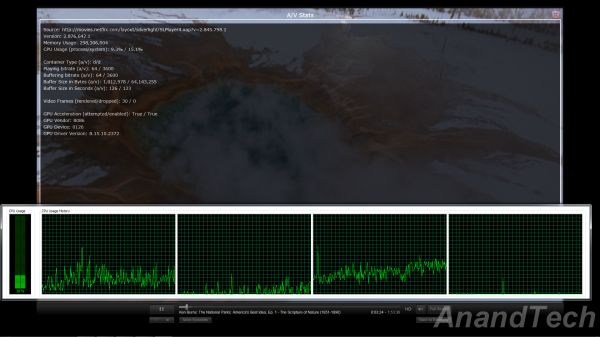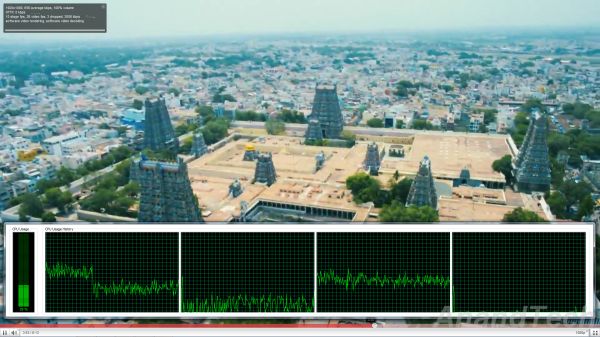ASRock CoreHT 252B Review
by Ganesh T S on September 2, 2011 3:45 AM EST- Posted in
- HTPC
- Intel
- ASRock
- Media Streamer
The ASRock CoreHT 252B is covered quite nicely with respect to networking hardware. With support for both Gigabit Ethernet and 802.11n, it really doesn't matter if you keep the unit beyond cable reach from the router. All our network streaming tests were carried out with a 300 Mbps 802.11n network (currently provided in my lab location by a RT-N16 802.11n gigabit router from Asus). We were easily able to stream HD clips of more than 50 Mbps. HD YouTube videos and HD Netflix streaming had no issues.
While on the topic of network streaming, let us take a brief look at how the system performs while accessing online video services. We used Flash 10.3 in Firefox 4 with Intel Graphics Driver v2372 for testing. The first set of screenshots below show the CPU usage while playing back a 1080p YouTube video with and without hardware acceleration enabled. This is the same clip used in all the other SFF HTPC reviews.
1080p YouTube HD Streaming without Hardware Acceleration

1080p YouTube HD Streaming with Hardware Acceleration (Flash in Firefox)
Unfortunately, enabling hardware acceleration in the Flash properties seems to result in only accelerated video rendering. The decode still ends up being done in software. This accounts for the ~5% decrease in CPU usage when hardware acceleration is enabled. Just before posting the review, we also confirmed that the issue still exists on IE9 / Firefox 6.0 with Flash 10.3.183.7. Another puzzling aspect was the fact that we could get hardware accelerated decoding for some videos occasionally.

1080p YouTube HD Streaming with Hardware Acceleration (Flash in IE9)
It looks like the Adobe Flash Player has some trouble in hooking up to the Intel DXVA library. Both AMD and NVIDIA platforms support GPU acceleration for Flash without issues. It is disappointing to note that the largest GPU vendor (in terms of install base) still hasn't got this working right.
Netflix streaming, on the other hand, uses Microsoft's Silverlight technology. Unlike Flash, hardware acceleration for the video decode process is not controlled by the user. It is upto the server side code to attempt GPU acceleration. Thankfully, Netflix does try to take advantage of the GPU's capabilities. This is evident from the A/V stats recorded while streaming a Netflix HD video at the maximum possible bitrate of 3.8 Mbps. While the video is definitely not 1080p, we observe that the CPU utilization of around 18% is lower than the CPU usage for a 1080p YouTube video.

Netflix HD Streaming with Hardware Acceleration
Users of media streamers streaming online videos often have to put up with messages of the sort 'This content is not available on TV connected devices' or need to queue up the videos on a PC before accessing them through their media streamer box. HTPC users don't need to worry about any such limitations.
On a side note, it is disappointing to see Netflix restrict its 1080p / DD+ 5.1 offerings to the PS3 and Roku 2. It is the PC platform which launched the streaming business for Netflix. It would be good if they do not relegate HTPC users to being second string consumers as their popularity grows.











54 Comments
View All Comments
DocJones - Friday, September 2, 2011 - link
I've been wanting to put together a media server with an i5 CPU just about down this line. I currently run Mezzmo as the server software since it does a pretty good job at transcribing video on the fly based on what device is requesting it.I wonder if this has enough juice to transcribe 1080p and send it over the wire to our media players, and if so... can it do more than one?
ganeshts - Friday, September 2, 2011 - link
For a server type situation, I would recommend a desktop chipset.However, the i5-2520M is very very capable.. Maybe you should ask Mezzmo whether they can take advantage of QuickSync?
DocJones - Friday, September 2, 2011 - link
i5 2405S better?http://ark.intel.com/products/55446/...he-2_50-GHz...
Something this form factor would be nice if it worked. Mezzmo folks pretty much say I need a true 4 core 8 thread CPU to perform transcoding on the fly. I find that hard to believe. Others have noted that a Intel Core 2 Quad Q8400 LGA775 'Yorkfield' 2.66GHz 4MB-cache while hot handles the job just fine.
They use ffmpeg so I don't think they support QuickSync right now.
ganeshts - Friday, September 2, 2011 - link
Being paid software, I think Mezzmo needs to pull up its socks and adopt QuickSync for its transcoding operations. I think they can afford to sign whatever NDAs are required for this purpose (Actually, I don't think they need any because Andrew Van Til (www.babgvant.com) has actually implemented QuickSync support in his DVRMSToolBox program).Please hound them about this. I am also personally interested in finding out whether QuickSync is flexible enough for media server software to take advantage of.
blckgrffn - Friday, September 2, 2011 - link
I would hope that this guy starts under $500, but seeing the prices on the Core HT100 at greater than $700, my enthusiasm is tempered a bit.icrf - Friday, September 2, 2011 - link
Agreed, for $500, I'd buy one.Since this is mostly laptop parts, what does a similarly spec'd laptop cost? No keyboard, touchpad, or screen saves some costs. What does this add that a laptop doesn't? A token remote control?
ganeshts - Friday, September 2, 2011 - link
Remote control + IR receiver and form factor combined with scale of manufacturing mean that the cost almost works out to be the same as that of a laptop.For many, a laptop can double up as a HTPC (even I used my notebook as a HTPC between 2005 and 2007), but PCs like these cater to those who need a quiet unobtrusive unit as part of the living room cabinet. Plus, this is a desktop replacement, i.e, you can schedule recordings with an external TV tuner when you are away from the home (or any other such usage scenario).
In the end, it is about horses for courses :)
cknobman - Friday, September 2, 2011 - link
ZBOX nano AD10cjs150 - Friday, September 2, 2011 - link
Initial reviews look very promising although probably best to get the bare bones version and kit out with own memory and an SSD.When available I am going to get one and play with it to see how well it works
icrf - Friday, September 2, 2011 - link
Agreed. It's likely less than half the price, and I can do without an optical drive. I plan to run Windows, so the Linux driver situation around AMD's video decoding hardware don't apply, either (assuming that hasn't been straightened out since I last read about it).Still, it is nice to have all that extra CPU power available for whatever the future brings. I'm just not sure it's going to be worth the several hundred dollars more they're likely going to be asking for it.
In any case, I'd still love to see a review here on the unit, comparing it to this one as a budget alternative. I am a big XBMC proponent (and Hulu Desktop), so I really liked seeing the detailed focus on it, something I'd like to see carried forward in future HTPC reviews.